Chitta Baral
Arizona State University
Stable Cinemetrics : Structured Taxonomy and Evaluation for Professional Video Generation
Sep 30, 2025Abstract:Recent advances in video generation have enabled high-fidelity video synthesis from user provided prompts. However, existing models and benchmarks fail to capture the complexity and requirements of professional video generation. Towards that goal, we introduce Stable Cinemetrics, a structured evaluation framework that formalizes filmmaking controls into four disentangled, hierarchical taxonomies: Setup, Event, Lighting, and Camera. Together, these taxonomies define 76 fine-grained control nodes grounded in industry practices. Using these taxonomies, we construct a benchmark of prompts aligned with professional use cases and develop an automated pipeline for prompt categorization and question generation, enabling independent evaluation of each control dimension. We conduct a large-scale human study spanning 10+ models and 20K videos, annotated by a pool of 80+ film professionals. Our analysis, both coarse and fine-grained reveal that even the strongest current models exhibit significant gaps, particularly in Events and Camera-related controls. To enable scalable evaluation, we train an automatic evaluator, a vision-language model aligned with expert annotations that outperforms existing zero-shot baselines. SCINE is the first approach to situate professional video generation within the landscape of video generative models, introducing taxonomies centered around cinematic controls and supporting them with structured evaluation pipelines and detailed analyses to guide future research.
AcT2I: Evaluating and Improving Action Depiction in Text-to-Image Models
Sep 19, 2025Abstract:Text-to-Image (T2I) models have recently achieved remarkable success in generating images from textual descriptions. However, challenges still persist in accurately rendering complex scenes where actions and interactions form the primary semantic focus. Our key observation in this work is that T2I models frequently struggle to capture nuanced and often implicit attributes inherent in action depiction, leading to generating images that lack key contextual details. To enable systematic evaluation, we introduce AcT2I, a benchmark designed to evaluate the performance of T2I models in generating images from action-centric prompts. We experimentally validate that leading T2I models do not fare well on AcT2I. We further hypothesize that this shortcoming arises from the incomplete representation of the inherent attributes and contextual dependencies in the training corpora of existing T2I models. We build upon this by developing a training-free, knowledge distillation technique utilizing Large Language Models to address this limitation. Specifically, we enhance prompts by incorporating dense information across three dimensions, observing that injecting prompts with temporal details significantly improves image generation accuracy, with our best model achieving an increase of 72%. Our findings highlight the limitations of current T2I methods in generating images that require complex reasoning and demonstrate that integrating linguistic knowledge in a systematic way can notably advance the generation of nuanced and contextually accurate images.
How Can Input Reformulation Improve Tool Usage Accuracy in a Complex Dynamic Environment? A Study on $τ$-bench
Aug 28, 2025Abstract:Recent advances in reasoning and planning capabilities of large language models (LLMs) have enabled their potential as autonomous agents capable of tool use in dynamic environments. However, in multi-turn conversational environments like $\tau$-bench, these agents often struggle with consistent reasoning, adherence to domain-specific policies, and extracting correct information over a long horizon of tool-calls and conversation. To capture and mitigate these failures, we conduct a comprehensive manual analysis of the common errors occurring in the conversation trajectories. We then experiment with reformulations of inputs to the tool-calling agent for improvement in agent decision making. Finally, we propose the Input-Reformulation Multi-Agent (IRMA) framework, which automatically reformulates user queries augmented with relevant domain rules and tool suggestions for the tool-calling agent to focus on. The results show that IRMA significantly outperforms ReAct, Function Calling, and Self-Reflection by 16.1%, 12.7%, and 19.1%, respectively, in overall pass^5 scores. These findings highlight the superior reliability and consistency of IRMA compared to other methods in dynamic environments.
ThinkTuning: Instilling Cognitive Reflections without Distillation
Aug 11, 2025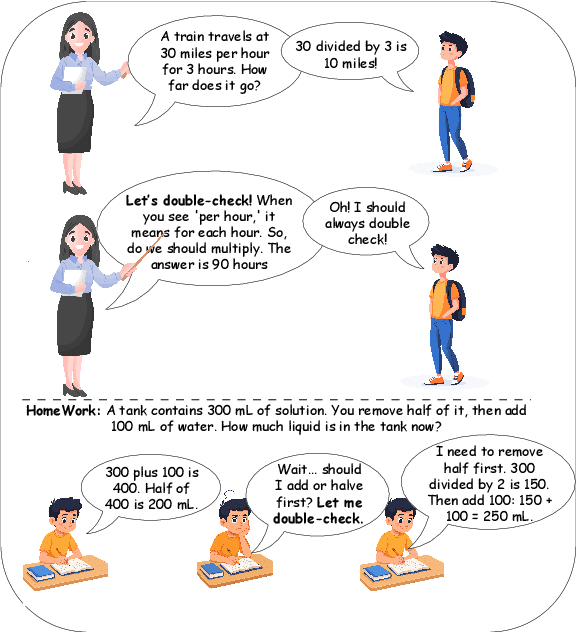

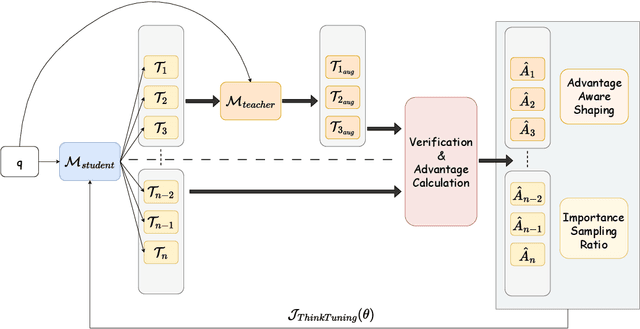

Abstract:Recent advances in test-time scaling have led to the emergence of thinking LLMs that exhibit self-reflective behaviors and multi-step reasoning. While RL drives this self-improvement paradigm, a recent study (Gandhi et al., 2025) shows that RL alone does not truly instill these new reasoning abilities - it merely draws out behaviors already present in the base models. This raises a question: How can we train the models that don't exhibit such thinking behavior to develop it in the first place? To this end, we propose ThinkTuning, a GRPO-based interactive training approach where we augment the rollouts of a student model with the guidance from a teacher model. A simple idea from classroom practice inspires our method: a teacher poses a problem, lets the student try an answer, then gives corrective feedback -- enough to point the mind in the right direction and then show the solution. Each piece of feedback reshapes the student's thoughts, leading them to arrive at the correct solution. Similarly, we find that this type of implicit supervision through feedback from a teacher model of the same size improves the reasoning capabilities of the student model. In particular, on average, our method shows a 3.85% improvement over zero-shot baselines across benchmarks, and on MATH-500, AIME and GPQA-Diamond it shows 2.08%, 2.23% and 3.99% improvements over the vanilla-GRPO baseline. Source code is available at https://github.com/3rdAT/ThinkTuning.
PLAN-TUNING: Post-Training Language Models to Learn Step-by-Step Planning for Complex Problem Solving
Jul 10, 2025Abstract:Recently, decomposing complex problems into simple subtasks--a crucial part of human-like natural planning--to solve the given problem has significantly boosted the performance of large language models (LLMs). However, leveraging such planning structures during post-training to boost the performance of smaller open-source LLMs remains underexplored. Motivated by this, we introduce PLAN-TUNING, a unified post-training framework that (i) distills synthetic task decompositions (termed "planning trajectories") from large-scale LLMs and (ii) fine-tunes smaller models via supervised and reinforcement-learning objectives designed to mimic these planning processes to improve complex reasoning. On GSM8k and the MATH benchmarks, plan-tuned models outperform strong baselines by an average $\sim7\%$. Furthermore, plan-tuned models show better generalization capabilities on out-of-domain datasets, with average $\sim10\%$ and $\sim12\%$ performance improvements on OlympiadBench and AIME 2024, respectively. Our detailed analysis demonstrates how planning trajectories improves complex reasoning capabilities, showing that PLAN-TUNING is an effective strategy for improving task-specific performance of smaller LLMs.
QA-LIGN: Aligning LLMs through Constitutionally Decomposed QA
Jun 09, 2025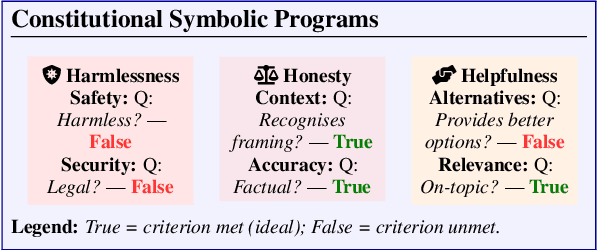
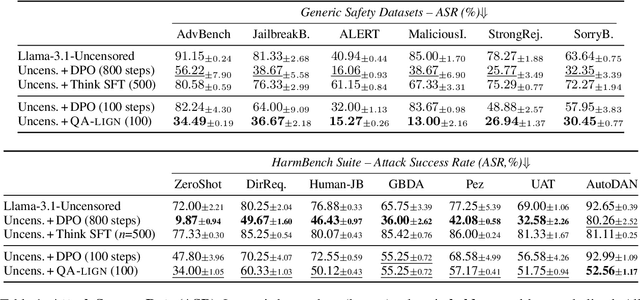
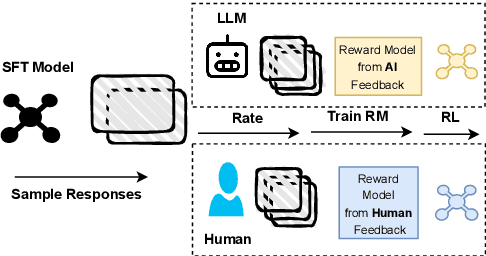
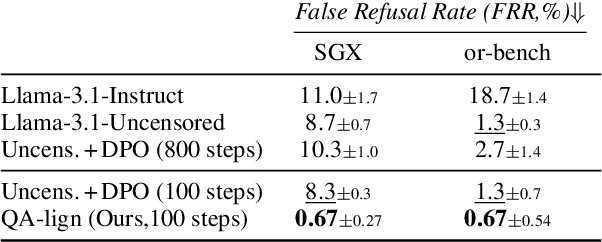
Abstract:Alignment of large language models with explicit principles (such as helpfulness, honesty, and harmlessness) is crucial for ensuring safe and reliable AI systems. However, standard reward-based alignment methods typically collapse diverse feedback into a single scalar reward, entangling multiple objectives into one opaque training signal, which hinders interpretability. In this work, we introduce QA-LIGN, an automatic symbolic reward decomposition approach that preserves the structure of each constitutional principle within the reward mechanism. Instead of training a black-box reward model that outputs a monolithic score, QA-LIGN formulates principle-specific evaluation questions and derives separate reward components for each principle, making it a drop-in reward model replacement. Experiments aligning an uncensored large language model with a set of constitutional principles demonstrate that QA-LIGN offers greater transparency and adaptability in the alignment process. At the same time, our approach achieves performance on par with or better than a DPO baseline. Overall, these results represent a step toward more interpretable and controllable alignment of language models, achieved without sacrificing end-task performance.
Map&Make: Schema Guided Text to Table Generation
May 29, 2025Abstract:Transforming dense, detailed, unstructured text into an interpretable and summarised table, also colloquially known as Text-to-Table generation, is an essential task for information retrieval. Current methods, however, miss out on how and what complex information to extract; they also lack the ability to infer data from the text. In this paper, we introduce a versatile approach, Map&Make, which "dissects" text into propositional atomic statements. This facilitates granular decomposition to extract the latent schema. The schema is then used to populate the tables that capture the qualitative nuances and the quantitative facts in the original text. Our approach is tested against two challenging datasets, Rotowire, renowned for its complex and multi-table schema, and Livesum, which demands numerical aggregation. By carefully identifying and correcting hallucination errors in Rotowire, we aim to achieve a cleaner and more reliable benchmark. We evaluate our method rigorously on a comprehensive suite of comparative and referenceless metrics. Our findings demonstrate significant improvement results across both datasets with better interpretability in Text-to-Table generation. Moreover, through detailed ablation studies and analyses, we investigate the factors contributing to superior performance and validate the practicality of our framework in structured summarization tasks.
GETReason: Enhancing Image Context Extraction through Hierarchical Multi-Agent Reasoning
May 29, 2025



Abstract:Publicly significant images from events hold valuable contextual information, crucial for journalism and education. However, existing methods often struggle to extract this relevance accurately. To address this, we introduce GETReason (Geospatial Event Temporal Reasoning), a framework that moves beyond surface-level image descriptions to infer deeper contextual meaning. We propose that extracting global event, temporal, and geospatial information enhances understanding of an image's significance. Additionally, we introduce GREAT (Geospatial Reasoning and Event Accuracy with Temporal Alignment), a new metric for evaluating reasoning-based image understanding. Our layered multi-agent approach, assessed using a reasoning-weighted metric, demonstrates that meaningful insights can be inferred, effectively linking images to their broader event context.
MMTBENCH: A Unified Benchmark for Complex Multimodal Table Reasoning
May 27, 2025Abstract:Multimodal tables those that integrate semi structured data with visual elements such as charts and maps are ubiquitous across real world domains, yet they pose a formidable challenge to current vision language models (VLMs). While Large Language models (LLMs) and VLMs have demonstrated strong capabilities in text and image understanding, their performance on complex, real world multimodal table reasoning remains unexplored. To bridge this gap, we introduce MMTBENCH (Multimodal Table Benchmark), a benchmark consisting of 500 real world multimodal tables drawn from diverse real world sources, with a total of 4021 question answer pairs. MMTBENCH questions cover four question types (Explicit, Implicit, Answer Mention, and Visual Based), five reasoning types (Mathematical, Extrema Identification, Fact Verification, Vision Based, and Others), and eight table types (Single/Multiple Entity, Maps and Charts with Entities, Single/Multiple Charts, Maps, and Visualizations). Extensive evaluation of state of the art models on all types reveals substantial performance gaps, particularly on questions requiring visual-based reasoning and multi-step inference. These findings show the urgent need for improved architectures that more tightly integrate vision and language processing. By providing a challenging, high-quality resource that mirrors the complexity of real-world tasks, MMTBENCH underscores its value as a resource for future research on multimodal tables.
Rethinking Information Synthesis in Multimodal Question Answering A Multi-Agent Perspective
May 27, 2025Abstract:Recent advances in multimodal question answering have primarily focused on combining heterogeneous modalities or fine-tuning multimodal large language models. While these approaches have shown strong performance, they often rely on a single, generalized reasoning strategy, overlooking the unique characteristics of each modality ultimately limiting both accuracy and interpretability. To address these limitations, we propose MAMMQA, a multi-agent QA framework for multimodal inputs spanning text, tables, and images. Our system includes two Visual Language Model (VLM) agents and one text-based Large Language Model (LLM) agent. The first VLM decomposes the user query into sub-questions and sequentially retrieves partial answers from each modality. The second VLM synthesizes and refines these results through cross-modal reasoning. Finally, the LLM integrates the insights into a cohesive answer. This modular design enhances interpretability by making the reasoning process transparent and allows each agent to operate within its domain of expertise. Experiments on diverse multimodal QA benchmarks demonstrate that our cooperative, multi-agent framework consistently outperforms existing baselines in both accuracy and robustness.
 Add to Chrome
Add to Chrome Add to Firefox
Add to Firefox Add to Edge
Add to Edge